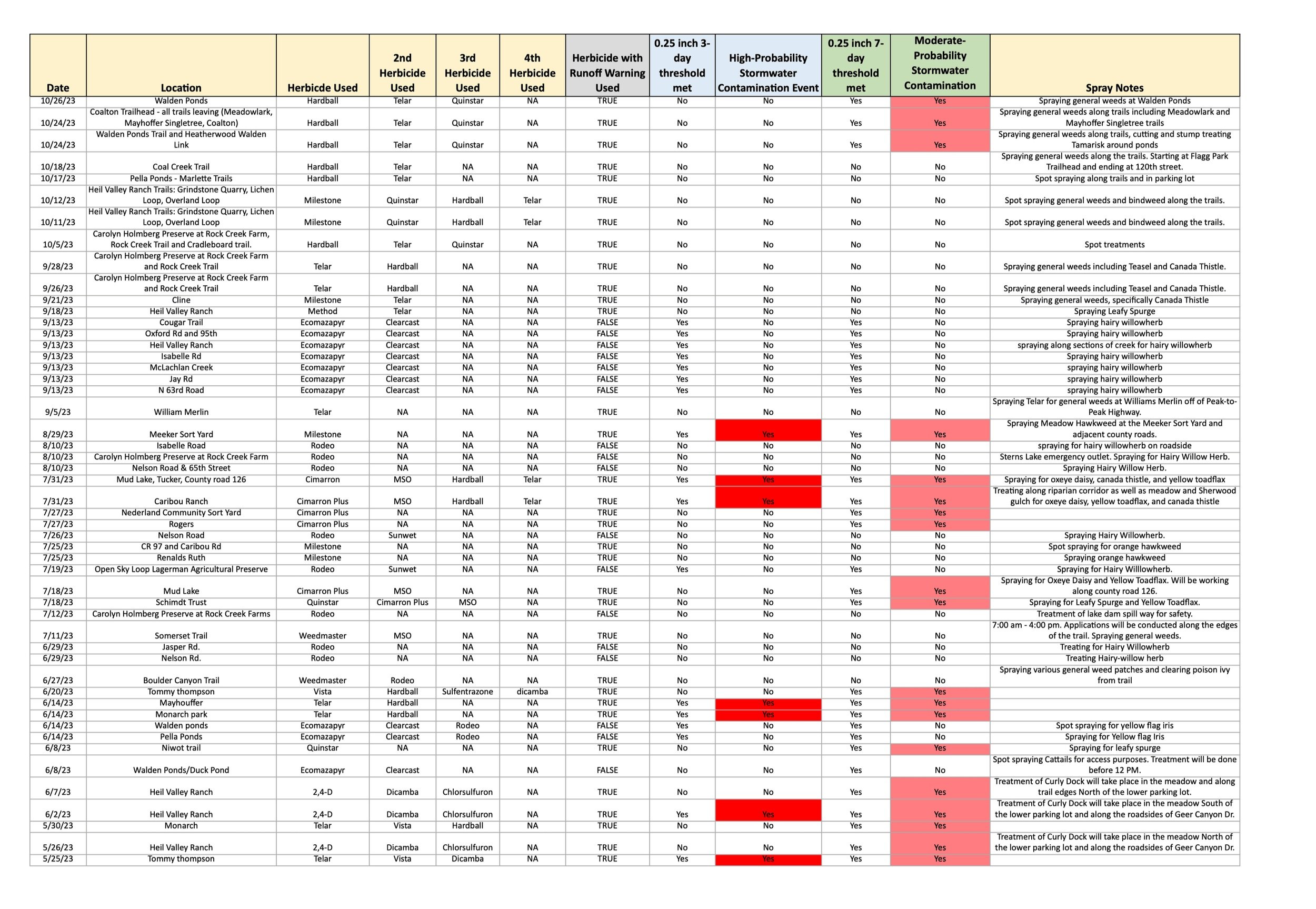Waterway Contamination and Run-Off Events Due to BCPOS Herbicide Use
One of the greatest concerns we have regarding Boulder County’s plan to continue using herbicides on our public lands are the known—on the label—deadly effects on on aquatic life, including invertebrates, fish, and amphibians, as well as the health implications of contaminated groundwater and irrigation water.
For example, Rejuvra™’s (Indaziflam) label states:
“This product is classified as having a high potential for reaching surface water via runoff for several months or more after application.”
Staff have repeatedly said that despite their many years of applying Rejuvra™ on Open Space lands, there has been no testing done on non-target impacts such as those on aquatic life. This map shows potential stream contamination from Indaziflam applications using data reported from BCPOS on its 2021 applications. Because of limited data accuracy and data availability, this map should be taken as a directional indication, not as documented evidence of contamination events.
Using available herbicide application data shared by BCPOS and comparing it to precipitation events, Mark Guttridge (Longmont organic farmer) created a more recent analysis of likely contamination events that can be accessed in the below chart.
These analyses were created by concerned citizens based on what data they could get from County Staff, however, if Staff wants to continue spraying Indaziflam and other herbicides with non-target impacts on aquatic life, then they should be designing ongoing environmental impact statements and making maps like this.
Below are Mark Guttridge’s comments to POSAC when he shared the above table of 2023 run-off risks from herbicide applications:
Dear POSAC members,
Earlier this year, I emailed you my concerns regarding likely surface water contamination occurring in our creeks and agricultural ditches due to Open Space’s widespread use of Rejuvra herbicide in the foothills in previous years. I also raised this concern with staff during the weed management bus tours this year and confirmed that the County is doing zero monitoring of stormwater runoff from these herbicide-treated areas. At the last POSAC meeting, I shared with you a specific example of a contamination event that likely occurred at Walden Ponds in October when herbicides toxic to aquatic life were sprayed days before a large snowstorm.
I went ahead and followed the County’s procedure and reported a stormwater contamination concern on the County’s Department of Public Health stormwater webpage. Jennifer Keyes, the Stormwater Quality Coordinator for the County was helpful reaching out to Open Space staff to get details and then following up with me. She has a follow-up meeting with the Weed Management staff planned to discuss runoff concerns.
It’s disappointing to me that none of the versions of the weed management plan presented thus far mention anything about runoff in the environmental section of herbicide use. This is a BIG HOLE in the current plan, and frustrating to see the issue continued to be ignored by staff despite multiple ecologists, hydrologists and environmentalists all bringing it up in the written part of the survey conducted by staff. In general, it seems like staff collected a record amount of public feedback on this weed management topic and then proceeded to ignore pretty much all of the community's input and proceeded with business as usual.
Jennifer shared with me that staff’s response to the stormwater complaint was that only small amounts of herbicides were used in spot treatments at Walden Ponds and that these aren’t a threat to runoff due to these herbicides having a Rainfast time of hours. Rainfast is a term used by chemical manufacturers to show how long it takes for the herbicide to begin passing through the cell walls of the plant and be effective. So, if you apply an herbicide with a four-hour Rainfast time and it rains hard a couple hours later, you wasted your money and it all ran off. The Rainfast time IS NOT when the runoff threat ends as some of the herbicide will dry and stay on the plant leaf. There is never 100% transmittal. I have experience in this from foliar sprays where we are putting compost teas or specific mineral nutrients and spraying them on plants to give them a nutrient or biological boost, I’d say at best that only 66% of the spray actually enters the plant and the rest stays as a dried material on the plant leaf or ground that will eventually be washed off with rain or irrigation.
These herbicide applications are definitely a threat to runoff contamination well after the Rainfast time. A good example of this is Cimarron herbicide used by Open Space this year, which has a 4-hour Rainfast time but still carries the following warning from EPA on the product label:
“This product may impact surface water quality due to runoff of rainwater. This product is classified as having high potential for reaching surface water via runoff for weeks after application.”
Even though Rejuvra herbicide wasn’t used in 2023, there were several other herbicides toxic to aquatic life that were used on our Open Space lands this year. I compiled the attached Excel document to show which applications this year had a high probability of contaminating surface water and found 8 spray events that fell into this category (rained over .25 inches within three days of application). An additional 15 spray events fell into the category of moderate potential for a contamination event (rained over .25 inches within seven days of application). These numbers are likely conservative as some of these herbicides have specific runoff warnings lasting weeks and even months. Many of these specific chemicals are toxic at the parts per million (ppm) concentrations so to me there is no safe “small amount” to spray, especially in aquatic habitats.
I shared this info with Jennifer from the County’s stormwater office but also wanted to bring it to your attention, we need all the voices we can put an end to taxpayer-funded water contamination on Open Space.
Sincerely,
Mark Guttridge

